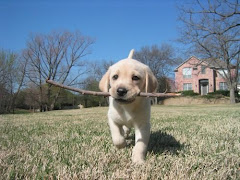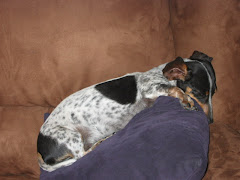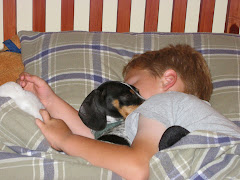I would like a dollar every time I have heard that. Actually, it is quite simple. Learn how
The Stay Command:
This is easily done but if taught incorrectly at the beginning you will lose the dogs ability to do well with future stays. The stay guidelines are as follows.
* Use firm voice commands
* Use firm hand signals
* Do the same command and hand signal all at the time.
* When leaving the dog always take off with your right foot first doing the stay.
* Always praise the dog immediately upon a correct response.
* Always correct the dog's incorrect action immediately also.
* Never walk backwards from the dog when leaving it.
* Have some trust in your dogs ability
* Always start off at a short distance, right at the dog's toes
* Always start off with a small amount of time (10 seconds) and don't push the dog so it breaks (moves) its stay.
* When you increase the distance you must decrease the time for that new distance and work up in time again.
* Work with repetition, reward and association techniques as described under the general obedience section.
* Work your way up slowly, take your time and finish on a good note
* Always play some kind of game after training has finished.
If you were to follow these guidelines things shouldn't be a problem. If possible it is best to obtain practical instruction from your local dog trainer. But if you read on I will give you the instructions for the sit stay. Then you can incorporate the same with the drop stay and the stand stay later on.
The Sit Stay
Have your dog sitting on your left-hand side from the heel. Once the dog is sitting quietly, use your right hand and place your palm directly in front of the dog's face (few centimeters from the dog's nose). As you perform this sit stay you need to give the command Stay in a firm voice. Then take off with your right foot and stand directly in front of the dog. You should now be facing your dog.
Note: Give the command once only and if the dog gets up tell the dog to Sit and this command should be done only once also. Keep your dog's attention by looking just above his head (no eye contact), or you can use food to gain its attention but don't excite the dog. Count to 10 or 15 then return back to the dog so the dog is on your left-hand side.
Count to 3 then praise the dog if it hasn't moved, this is very important. The reason I count to 3 before praising on the end of this exercise is to reduce the chance of the dog breaking its stay. The dog can get excited when you return back to its side and it may move because it knows it would get a pat as soon as you get back. Do not reward if the dog moves (breaks its stay).
Not moving means it is still in the same position as you left it when you told it to stay. Your dog must not even lie down. If your dog did move then you have failed not the dog.
It is your responsibility to make sure the dog does not move. You need to be able to know when your dog is anticipating a move. If it has moved it is too late to correct and you must start again saying nothing to the dog. If you anticipate your dog is about to move or lie down gently pull up on the collar with the leash and say Stay.
Hold the dog in this position until you are satisfied it will stay, wait five seconds then return to the dog's side. If the dog stays you can practise this three times then increase each time up to a maximum of 30 seconds. Then call it a day and finish on a good note. Practise this over the next few weeks and slowly build up the time in the required position. Only when you feel the dog is ready then you can move forward one place at a time.
Keep looking for the dogs anticipation to move or lie down, if it attempts this say to the dog Stay or Sit and / or walk towards the dog and hold it in the position until you feel comfortable with your dog's effort. Never be too hard on your dog and don't over work the procedures. Do not walk backwards away from your dog either, walk forward and turn sharp to face your dog. If it moves you have gone too far on your training.
Always finish on a good note and eventually you can work up to a sit stay from about 10 to 30 paces for around three minutes, but do not exceed this. The drop stay can be done to a maximum of 10 minutes, which includes a couple of minutes out of sight.
Remember that if your dog breaks its stay you need to return to a level your dog can accomplish comfortably. There are always plenty of guides to training dogs, both in print and online. But the trick is to find the best ones!
That's why we've exhaustively checked out dozens -hundreds! - of guides on the Web to find the best guides and sites out there!
Go to http://www.here-is-your.info/About/DogTraining/
Dachshunds In Film: The Lemon Drop Kid
12 years ago













No comments:
Post a Comment